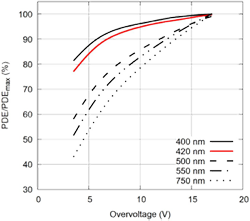Broadcom's SiPM data sheets detail key performance parameters of their silicon photomultipliers - the effects of temperature on the performance of the SiPM can be important and are discussed here.
Breakdown Voltage:
Silicon Photomultipliers have a positive temperature coefficient of the breakdown voltage - the breakdown voltage increases with increasing temperature. The relationship between breakdown voltage and temperature is linear - for Broadcom's NUV-MT SiPMs the figure is +30mV/°C.
It can therefore be seen that if a constant Bias Voltage is applied whilst the temperature increases the applied Overbias will reduce by 30mV/°C.
Temperature therefore has an influence on all SiPM characteristics - not just those which are directly thermally-driven such as the Dark Count Rate.
Dark Count Rate:
Spontaneous breakdown of a Geiger-mode SPAD triggered by thermally generated electrons will release the same charge as when a photon is detected. These breakdowns are termed "Dark Counts" and are indistinguishable from actual photon counts. The frequency of these events is termed the "Dark Count Rate" (DCR) and the sum of all of the dark counts generates the "Dark Current".
Increasing temperature will increase the carrier density in silicon and so Dark Counts are the only attribute of an SiPM which are directly thermally driven.
However, since increasing Overbias will increase the breakdown probability DCR also has an Overbias dependency which is worth highlighting given the effect of temperature on the breakdown voltage and Overbias discussed above.
The plot below provides detailed Dark Current versus Bias Voltage curves for a single 6mm channel of the AFBR-S4N66P024M 2x1 array from -20°C to +60°C between 0V and >50V bias.

- The gradual increase of the Dark Current with increasing Temperature for any given bias voltage is clearly seen
- The rapid increase of the Dark Current at the Breakdown Voltage is also evident
- Dark Current is close to linear in the typical 35-45V operating range - equivalent to Overbias of 2.5V to 12.5V
Gain:
 The Gain of an SiPM is indirectly affected by Temperature because the charge carried by the SPAD has a positive Overbias Voltage coefficient.
The Gain of an SiPM is indirectly affected by Temperature because the charge carried by the SPAD has a positive Overbias Voltage coefficient.
The plot shows the Gain versus Overbias for Broadcom's NUV-MT technology with large 40µm pitch SPADs. The data sheet quotes Gain of 7.3x106 at 12V Overbias and the plot demonstrates linearity between ~4M at 6V and 9M at 16V.
Since increasing temperature results in an increase in the Breakdown Voltage it is clear that the Overbias will change with temperature under a fixed Bias Voltage.
Unlike DCR which is thermally driven it is possible to stabilise Gain by actively monitoring the temperature of the SiPM and stabilising the Overbias via active control of the applied Bias Voltage using the +30mV/°C coefficient.
Photon Detection Efficiency:
 Photon Detection Efficiency (PDE) also has a positive coefficient w.r.t Overbias and so has an indirect relationship with Temperature if the Overbias is not stabilised as suggested above.
Photon Detection Efficiency (PDE) also has a positive coefficient w.r.t Overbias and so has an indirect relationship with Temperature if the Overbias is not stabilised as suggested above.
This plot shows PDE at increasing overvoltage for the NUV-MT technology from 400nm to 750nm and demonstrates the increase in PDE until all wavelengths reach their maximum PDE at ~17V Overbias.
It is also clear that the increase in PDE relative to the maximum is far steeper for longer wavelengths whereas shorter wavelengths are closer to their maximum at much lower Overbias. This means that PDE for shorter wavelengths is affected less by changes in temperature/Overbias than longer wavelengths.
Demonstration of the Effects of Temperature Change:

The effect of a varying Overbias due to changes in the breakdown voltage can be seen in the shift of the 1p.e. and 2p.e. peaks in the measured charge histogram which shows 4 different Overbiases (4.0 to 4.3V) equivalent to a temperature change of 10°C.
Conclusion:
In the vast majority of uses SiPMs are used with a fixed Bias Voltage as small changes in Overbias are not critical. In cases where temperature effects need to be accommodated then active control of the Bias/Overbias can be used to stabilise Gain and PDE. Temperature stabilisation using thermoelectric coolers or other techniques is rarely cost effective.
Where Gain and PDE stabilisation is required users take advantage of the NUV-MT's low and predictable coefficient of +30mV/°C by monitoring the temperature and adjusting the bias voltage so that a constant Overbias is maintained. Manufacturers of products such as handheld spectroscopic radiation detectors will use this approach to stabilise Gain and PDE so that a particular energy peak will always occur in the same Multi-channel Analyser (MCA) channel.
It should be noted that the overbias stabilisation approach WILL NOT affect other temperature-driven affects such as the increase in Dark Count Rate (DCR) and associated Dark Current - it is therefore important to consider the operating temperature range of a system employing SiPMs to ensure that the minimum signal remains detectable at the maximum operating temperature. In the case of the handheld spectroscopic radiation detector this would mean ensuring that the Noise level remains below the minimum detectable energy channel of the MCA.
This might be achieved by reducing the Overbias - for example the DCR of the NUV-MT technology is 125kcps/mm² at 12V Overbias and reduces significantly to ~80kcps at 7V. Since Gain and PDE is also reduced this approach does compromise the performance at lower temperature levels as SiPMs are rarely used with dynamic Overbias control to actively change characteristics - the typical use is to stabilise Gain and PDE.
Broadcom have produced a number of helpful application notes which discuss the issues highlighted in this article. These can be accessed below
For more detail please visit the Support pages using the links in this article and on the right hand side of this page.


